How do I prepare for a piano appointment?
March 25, 2022 •Stephen Reed
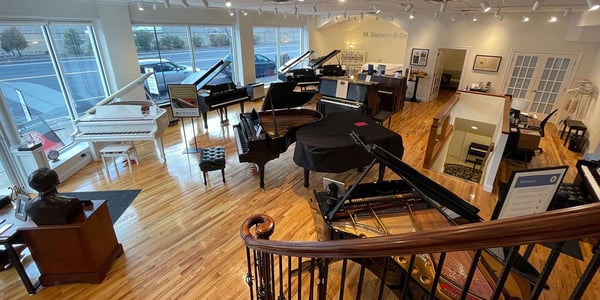
Buying a piano is a significant investment. Seeking solid information and asking questions of a seasoned, trustworthy piano consultant is simply prudent anytime one buys an instrument costing several thousand dollars.
But how do you prepare for a piano appointment? If the “piano world” is completely new to you, going into the process essentially blind can be a recipe for confusion.

In contrast, discovering a guide in the form of a knowledgeable, honest piano store consultant can be a relief. Now you have a professional who can start answering your questions and who will begin to learn your priorities for your upcoming piano.
M. Steinert & Sons has always taken this relational approach to its customers and prospective customers. Our piano sales consultants take the time to understand your piano needs and then work to find the kind of models that may hit the target for you.
It’s a jungle out there, filled with a variety of brands, price points, and varying degrees of musical quality in each piano you sample. Without a guide, you could easily get lost and quite possibly make a poor choice for your piano, which would be a lasting regret.
By the end of this article, you will understand how to reflect and prepare yourself to make this kind of process work best for you. Additionally, you will learn about the piano buying fundamentals of understanding pianos’ sizes, colors, touches, tones, and budgets.
You’ll come away from this article with the information you need to make the first meeting with your piano consultant a productive one.
What is your goal? Examining your desire to own a piano
Before launching into your piano search, take some time to reflect on what has brought you to this point. Why do you want a piano? Is it simply for you or a family member to learn how to play? Is it something you’ve always wanted that you are now in a position to afford? A little bit of both?
Jonathan Yourtee is a piano consultant with M. Steinert & Sons, with a background in playing the piano. Jonathan encourages each customer to do some thinking on their own before they come to the showroom.
“I ask my customers to sit down for 5-10 minutes or more and just refresh their memory as to their goal in purchasing a piano,” says Jonathan.
Every customer is different. Some people may have wanted to learn to play since childhood and never had the time or money before to pursue it. Others played before but life got in the way. So now they want to get back into it.
“The individual customer’s reasons for purchasing a piano informs the five areas I ask them to think about next before buying a piano,” says Jonathan. “Size, color, touch, tone, and their budget.”
Size: How big should your piano be?
People who can afford a Steinway Model D concert grand may be swept away by its epic size and volume. But unless they have a space that can accommodate a nearly 9’ concert grand, it may well be more piano than they can use.
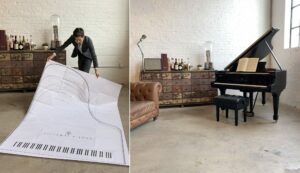
“A piano shouldn’t take up more than half of a room,” says Jonathan. “That’s a good rule to keep in mind not only in terms of whether a given piano will fit well in the room but also in terms of the size of the sound.”
The piano industry has accommodated all manner of sizes and sounds for individual buyers over the years. Not only are there a wide range of grand piano sizes, from concert grands to baby grands, but upright pianos have long had a favored place in smaller spaces.
Jonathan uses piano templates to determine what kinds of pianos can fit a given space at a customer’s home. Such templates can be extraordinarily helpful early on to narrow down the field of piano models for a given space.
Many are surprised to see how a grand piano can often fit in the space allotted to an upright.
Color: Classic black, different finishes, and wrapping
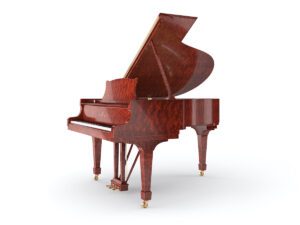
Whether it’s an ebony polished look or a black satin matte, black has emerged over the years as the color that goes with anything and has top re-sale value. A walnut or mahogany finish might be popular one year but not another; meanwhile black is always “in.”
Having said that, many buyers like having the option of individualizing their purchase. They enjoy reading information about different colors and designs for a piano’s case online before their visit with their piano consultant.
For example, Steinway’s Crown Jewel Collection of pianos features a wide variety of cases with exotic woods from around the world. These are the same exact Steinway model otherwise–just a jazzy exterior to add something special to a room.
One new trend that offers the buyer even more solid colors to choose from involves wrapping. Wrapping is becoming more popular and is offered at M. Steinert & Sons.
Touch: Lighter or heavier?
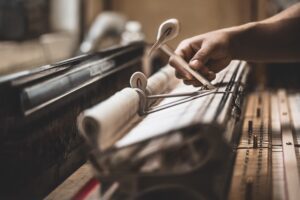
How do you want the keys to feel? Unless you’re a professional pianist, you may not have thought about this before. But brands differ in feel and weighting of touch, which involves the piano's action, the hammers hitting the strings. Is the feel stiff, easy, or something in between?
A piano’s touch is one of the most practical of considerations because if you take home a piano whose touch is one the player doesn’t like or is not able to express their musical intentions, there goes the ballgame! This is especially true with young piano students.
“I always tell customers to bring their children with them, too, if they will be playing the piano,” says Jonathan. “Bring them to the first visit with the piano consultant. Have the kids involved from the beginning.”
Tone: Bright or rich? A piano’s tone is part of its personality for a lifetime of playing
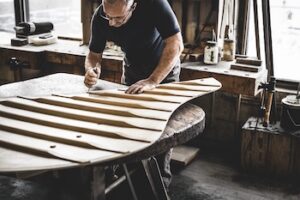
While some jazz pianists like the way a brighter sounding piano punches through the sound of the other instruments in the band, more classically-associated brands like Steinway have their jazz pianist fans, as well.
After all, the same various colors stemming from a Steinway’s soundboard and rim can be used to express emotions in a wide range of music.
Steinway’s tone is characterized by its warm, well-rounded, bell-like tone. Elements of that Steinway sound is found in the designs of its sister brands, Boston and Essex.
Reading about how others describe the tone of various piano brands will give you a better understanding of what you hear when you sample different pianos later with your piano consultant.
Budget: The most musical value for what you can afford
As with any significant purchase, calculating your budget is naturally a key factor for the piano you purchase. Would a better model be worth stretching one’s budget?
Like anything else, the more expensive piano models have advantages, like a more nuanced touch and tone, resulting in greater musical expression.
Moreover, if they are made of better woods, they will usually last longer and will definitely have greater resale value if you want to buy another piano later.
The higher-priced pianos like Steinway, which are handcrafted rather than manufactured, have prices that reflect U.S. and German labor costs at their factories.
However, the piano industry has met the need for more affordable pianos, so if your budget is something lower than a new Steinway price, look into Steinway-designed Boston and Essex lines, as well as Yamaha and Kawai.
Readying for your first piano appointment
Jonathan says that as you begin to get familiarized with these five subject areas for pianos, you’ll be able to hit the ground running with your first piano consultant visit. You’ll have a lot to talk about, so try to carve out adequate time for your visit to the showroom.
“I ask customers to try for a 60 or 90 minutes initial meeting, just so we can get acquainted better and so that I can begin to get a feel for their particular piano needs,” noted Jonathan.
Choosing a piano deserves a bit of time to do it right. If you were in the market for a luxury automobile like a Lamborghini or a Porsche, wouldn’t you want to know about their features? What makes them special. How are they made?
An experienced piano consultant can save you time and money by spending a little more time upfront to really understand why you’re buying a piano and what your expectations are.
We hope to see you at our showroom in Newton, where one of our highly-experienced piano consultants will show you hospitality and start understanding your piano needs.
In the meantime, keep reading in preparation for your first meeting with the piano consultant of your choice. If you want to learn how a piano maker like Steinway makes their piano, you’ll enjoy the following piece. Steinway craftspeople create the company’s pianos touch and tone daily:
Featured Articles
Categories
- Beginner Pianos (23)
- Boston Pianos (15)
- Comparisons (30)
- Designer and Specialty Pianos (8)
- Essex Pianos (10)
- Events (11)
- Featured (24)
- Institutional (3)
- Joy of Piano (15)
- Learning About Pianos (69)
- News (35)
- Pricing and Cost (19)
- Resource Center (122)
- Roland Pianos (6)
- Spirio (15)
- Steinway Pianos (70)
- Student (14)
- Teacher (13)
- Used Pianos (20)
- Videos (19)

